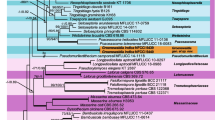Abstract
A dematiaceous hyphomycete with erect unbranched conidiophore stipes and Cladosporium-like branched conidial chains arranged at nodes along the stipe was found on living leaves of wild banana (Musa itinerans) in Taiwan. Scanning electron microscopy indicated a type of conidiogenous loci differing from that of Cladosporium by lacking the cleft between raised center and margin. Molecular phylogenetic analyses of several loci (LSU, ITS, TEF, RPB2) indicated a relationship with cercosporoid fungi (Mycosphaerellaceae). Since there is no other known lineage with similar morphology or DNA sequences, the new genus and species Cladocillium musae is proposed.



Similar content being viewed by others
References
Bensch K, Braun U, Groenewald JZ, Crous PW (2012) The genus Cladosporium. Stud Mycol 72(1):1–401
Carbone I, Kohn LM (1999) A method for designing primer sets for speciation studies in filamentous ascomycetes. Mycologia 91:553–556
Chiu H-L, Shii C-T, Yang TYA (2011) A new variety of Musa itinerans (Musaceae) in Taiwan. Novon 21:405–412
Gardes M, Bruns TD (1993) ITS primers with enhanced specificity for Basidiomycetes: application to identification of mycorrhizae and rusts. Mol Ecol 2:113–118
Hofstetter V, Buyck B, Eyssartier G, Schnee S, Gindro K (2019) The unbearable lightness of sequenced-based identification. Fungal Divers 96:243–284
Jones DR (2019) Handbook of diseases of banana, abacá and enset. CAB International, Boston
Kirschner R, Piepenbring M (2014) New records of three Ramichloridium species on banana leaves in Panama and Taiwan. Mycoscience 55:260–267
Kurtzman CP, Robnett CJ (1997) Identification of clinically important ascomycetous yeasts based on nucleotide divergence in the 5'end of the large-subunit (26S) ribosomal DNA gene. J Clin Microbiol 35(5):1216–1223
Marín DH, Romero RA, Guzmán M, Sutton TB (2003) Black sigatoka: An increasing threat to banana cultivation. Plant Dis 87(3):208–222
Pan F-J (2014) Formosan Plant Book, 2nd edn. Yuan-Liou Publishing Co., Ltd., Taipei 潘富俊2014福爾摩莎植物記.二版.遠流出版公司,臺北
Ploetz RC (1994) Panama disease: Return of the first banana menace. Int J Pest Manag 40(4):326–336
Quaedvlieg W, Verkley GJM, Shin HD, Barretto RW, Alfenas AC, Swart WJ, Groenewald JZ, Crous PW (2013) Sizing up Septoria. Stud Mycol 75:307–390
Quaedvlieg W, Binder M, Groenewald JZ, Summerell BA, Carnegie AJ, Burgess TI, Crous PW (2014) Introducing the Consolidated Species Concept to resolve species in the Teratosphaeriaceae. Persoonia 33:1–40
Stadler M, Lambert C, Wibberg D, Kalinowski J, Cox RJ, Kolařík M, Kuhnert E (2020) Intragenomic polymorphisms in the ITS region of high-quality genomes of the Hypoxylaceae (Xylariales, Ascomycota). Mycol Prog 19:235–245
Verkley GJ, Quaedvlieg W, Shin HD, Crous PW (2013) A new approach to species delimitation in Septoria. Stud Mycol 75(1):213–305
White TJ, Bruns TD, Lee S, Taylor J (1990) Amplification and direct sequencing of fungal ribosomal RNA genes for phylogenetics. In: Innis MA, Gelfand DH, Sninsky JJ, White TJ (eds) PCR protocols, a guide to methods and applications. Academic Press, San Diego, pp 315–322
Zalar P, de Hoog GS, Schroers HJ, Crous PW, Groenewald JZ, Gunde-Cimerman N (2007) Phylogeny and ecology of the ubiquitous saprobe Cladosporium sphaerospermum, with descriptions of seven new species from hypersaline environments. Stud Mycol 58:157–183
Zhan G, Tian Y, Wang F, Chen X, Guo J, Jiao M, Huang L, Kang Z (2014) A novel fungal hyperparasite of Puccinia striiformis f. sp. tritici, the causal agent of wheat stripe rust. PLoS One 9(11):e111484
Funding
The study was supported by the Ministry of Science & Technology, Taiwan (NSC 102–2621–B–008–001–MY3 and MOST 108-2621-B-002-007).
Author information
Authors and Affiliations
Corresponding author
Additional information
Section Editor: Gerhard Rambold
Publisher’s note
Springer Nature remains neutral with regard to jurisdictional claims in published maps and institutional affiliations.
Rights and permissions
About this article
Cite this article
Chen, CH., Hsieh, SY., Yeh, YH. et al. Cladocillium musae, a new genus and species of cercosporoid fungi (Mycosphaerellaceae) on wild banana in Taiwan. Mycol Progress 19, 837–843 (2020). https://doi.org/10.1007/s11557-020-01595-3
Received:
Revised:
Accepted:
Published:
Issue Date:
DOI: https://doi.org/10.1007/s11557-020-01595-3




